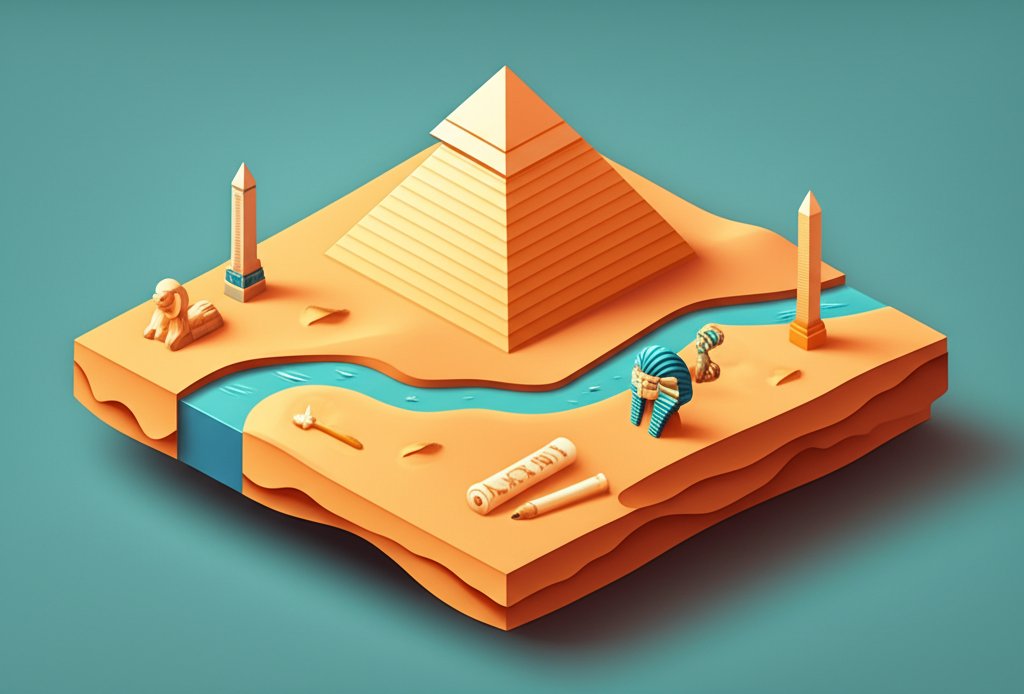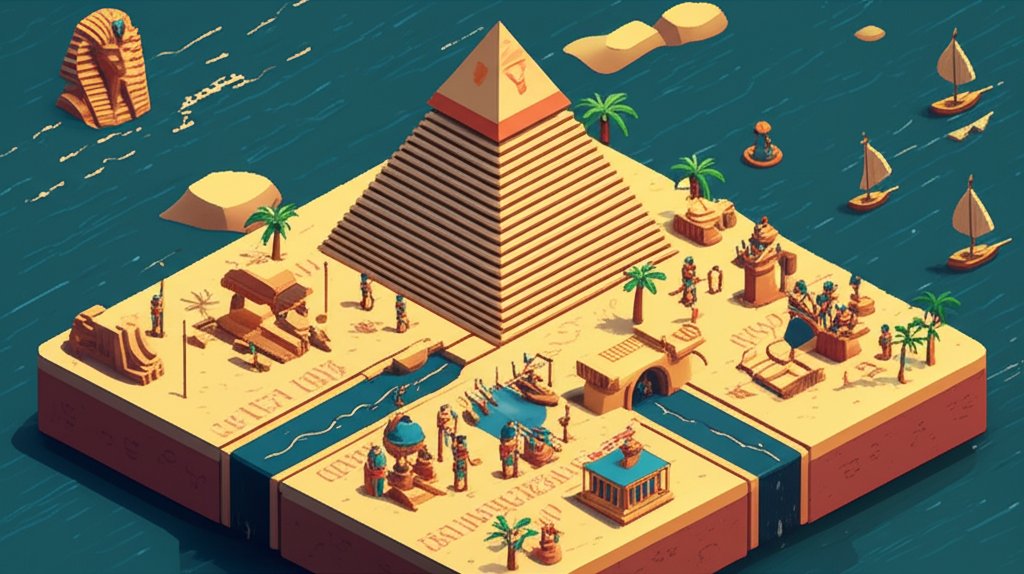Embark on an extraordinary journey through the Egyptian civilization timeline, a chronological odyssey unveiling the rise and fall of pharaohs, the construction of monumental wonders, and the enduring legacy of one of humanity’s most captivating societies. From its prehistoric origins along the fertile Nile to its eventual integration into vast empires, understanding the timeline of Egyptian civilization offers profound insights into ancient ingenuity, spiritual depth, and political evolution. This article will meticulously chart the pivotal periods, influential dynasties, and significant events that shaped Egypt’s destiny, ensuring you gain a comprehensive understanding of this remarkable egypt history timeline.
The Dawn of a Civilization: Pre-Dynastic & Early Dynastic Periods (c. 5000 – 2686 BCE)
To gain a broader perspective on how Egypt fits into the bigger picture, explore this ancient history timeline, which puts its developments in context with other early civilizations.

Long before the pyramids pierced the desert sky, the foundations of the Egyptian civilization timeline were laid along the banks of the Nile. This formative era witnessed the gradual development of settled communities into a unified kingdom.
Formative Years: From Nomads to Nile Settlements (c. 5000 – 3100 BCE)
The story of ancient Egypt begins in the Predynastic Period, a time marked by scattered Neolithic communities thriving in the Nile River Valley. Around 5000 BCE, organized farming began, transforming nomadic hunter-gatherer groups into settled agricultural societies. Cultures like the Badarian and Naqada (Naqada I, II, and III, spanning roughly 4300-3000 BCE) emerged, each contributing to the cultural and technological bedrock of future Egyptian grandeur. During this period, crucial advancements such as early tomb building and sophisticated burial rituals developed around 4000 BCE, reflecting a growing belief in the afterlife. By approximately 3200-3500 BCE, the intricate system of hieroglyphic writing began to take shape, allowing for the recording of history, rituals, and administration—a monumental step in the timeline of Egyptian civilization. This era saw Egypt divided into two distinct regions: Upper (southern) Egypt and Lower (northern) Egypt, each with its own customs and leadership.
The Unification of Egypt: Narmer and the First Dynasties (c. 3100 – 2686 BCE)
The Early Dynastic Period (Dynasties 1-2) kicks off the traditional egypt history timeline with the monumental unification of Upper and Lower Egypt. While historical accounts vary, the figure of Narmer (often identified with the legendary Menes) is credited with this pivotal achievement around 3100 BCE. His victory led to the establishment of the iconic double crown, symbolizing the combined sovereignty over both lands. The new capital was established at Memphis, strategically located at the junction of Upper and Lower Egypt, facilitating centralized governance. The First Dynasty fostered an environment where scribes, sculptors, and other artists flourished, establishing many of the artistic and architectural conventions that would define Egyptian art for millennia. This era saw the solidifying of royal iconography, the development of sophisticated administrative structures, and the early use of scale in artwork to denote status. Notable figures like Imhotep, an architect, physician, and polymath from the Third Dynasty, are believed to have begun their influential work towards the end of this period, contributing significantly to medical texts and architectural innovation.
The Age of Pyramids: Unveiling the Old Kingdom (c. 2686 – 2181 BCE)

The Old Kingdom Egypt timeline is synonymous with an era of unparalleled architectural ambition, centralized power, and artistic brilliance, often hailed as the “Age of Pyramids.” This period (Dynasties 3-6) represents a zenith of early Egyptian civilization.
Architectural Grandeur and Centralized Power (c. 2686 – 2181 BCE)
The Third Dynasty inaugurated the Old Kingdom with a revolutionary leap in architecture. For King Djoser, the vizier Imhotep designed the world’s first large-scale stone building—the Step Pyramid at Saqqara. This groundbreaking structure not only demonstrated advanced engineering skills but also symbolized the absolute power of the pharaoh, who was considered a living god. The Fourth Dynasty truly solidified the old kingdom egypt timeline as a period of monumental building. Pharaohs Khufu, Khafre, and Menkaure commissioned the iconic Great Pyramids of Giza, constructed around 2580-2560 BCE. These colossal structures, along with the enigmatic Great Sphinx of Giza, stand as enduring testaments to the organizational capabilities, mathematical understanding, and astronomical knowledge of ancient Egyptians. The construction of these wonders required a highly centralized bureaucracy, efficient resource management, and a vast, skilled workforce, all overseen by the pharaoh and his elite administration. This era saw the standards for royal and elite art reach extraordinary heights, marking a critical peak in the timeline of Egyptian civilization.
Society, Culture, and the Pharaoh’s Role
During the Old Kingdom, Egyptian society was highly stratified. At its apex was the pharaoh, whose divine authority ensured cosmic order (Ma’at) and stability. Below him were a complex network of viziers, nomarchs (provincial governors), scribes, priests, and artisans. The flourishing of sophisticated administration allowed for extensive public works, efficient taxation, and the distribution of resources. Iron tools, a significant technological advancement, allowed artisans to work with increasingly hard stones, leading to a boom in stone sculpture and the creation of highly refined bronze statuary. Minor arts, including alabaster vases, faience pottery, glass, ivories, and metalwork, also flourished. Religious beliefs centered on the pharaoh’s journey to the afterlife, with elaborate burial rituals and the development of tomb depictions featuring gods and the afterlife (around 4000 BCE, intensifying in this period), further emphasizing the importance of securing eternal life for the divine ruler and elite.
Cycles of Unity and Disunity: Intermediate Periods & Middle Kingdom (c. 2181 – 1650 BCE)
The egypt history timeline is not a continuous ascent but a dynamic interplay of strength and fragmentation. Following the Old Kingdom’s grandeur, Egypt experienced periods of decentralization, followed by a powerful resurgence.
The First Intermediate Period: Decentralization and Regional Power (c. 2181 – 2055 BCE)
The First Intermediate Period (Dynasties 7-11, early part) marked a sharp decline from the centralized authority of the Old Kingdom. The power of the pharaoh waned, partly due to the increasing autonomy of provincial governors (nomarchs) and a series of low Nile floods leading to economic hardship. Political upheaval fragmented Egypt, leading to regional power struggles between different local rulers. The central government in Memphis lost control, and the country was effectively divided. This instability also impacted artistic and architectural quality, as resources and centralized patronage diminished. However, this period also saw the rise of new artistic styles and a broadening of religious beliefs, as the funerary cult of Osiris gained prominence, promising an afterlife to commoners, not just the pharaoh.
Renaissance of Power: The Middle Kingdom’s Resurgence (c. 2055 – 1650 BCE)
From the ashes of the First Intermediate Period, the Middle Kingdom (Dynasties 11-13) emerged as a period of renewed stability, prosperity, and cultural brilliance. Pharaoh Mentuhotep II of Thebes played a pivotal role in reunifying Egypt, establishing Thebes as a prominent capital and ushering in a renaissance. This era is a critical chapter in the egyptian civilization timeline, witnessing a restoration of central authority and significant territorial expansion. Pharaohs such as Senusret I and Amenemhat III solidified Egypt’s borders, embarked on ambitious building projects (though less focused on colossal pyramids, more on temples and fortresses), and commissioned exquisite works of art. The Middle Kingdom is often considered a golden age for Egyptian literature, with texts like “The Tale of Sinuhe” and “The Story of the Shipwrecked Sailor” showcasing sophisticated narratives and ethical reflections. Advances in writing and a deeper exploration of religious thought characterized this period.
The Second Intermediate Period: Hyksos Rule and Innovation (c. 1650 – 1550 BCE)
Another period of fragmentation, the Second Intermediate Period (Dynasties 14-17), saw the weakening of central power once again. This time, Egypt faced a significant external threat: the Hyksos. These “rulers of foreign lands,” originating from Western Asia, slowly infiltrated and eventually dominated Lower Egypt, establishing their capital at Avaris in the Nile Delta. While traditionally depicted as invaders, their presence profoundly impacted Egyptian military technology and culture. They introduced new warfare innovations such as the composite bow, improved daggers and swords, and most significantly, the horse-drawn chariot. Although an era of foreign rule, the Hyksos presence served as a catalyst, indirectly preparing Egypt for its future as a dominant empire. Concurrent with Hyksos rule in the North, a line of native Egyptian pharaohs maintained control over Upper Egypt from Thebes, setting the stage for the dramatic reunification and expansion that would follow.
The Golden Age of Empire: The New Kingdom (c. 1550 – 1070 BCE)
The New Kingdom (Dynasties 18-20) stands as the pinnacle of the Egyptian empire timeline, an era defined by unprecedented military might, vast territorial expansion, and monumental architectural and cultural achievements. Emerging after the expulsion of the Hyksos, Egypt transformed into a dominant super-regional power.
Forging an Empire: Military Conquests and Expansion (c. 1550 – 1070 BCE)
The New Kingdom commenced with a fierce determination to secure Egypt’s borders and prevent future foreign incursions. Ahmose I, founder of the 18th Dynasty, successfully expelled the Hyksos, ushering in an era of aggressive expansionism. Pharaohs like Thutmose I and especially Thutmose III (“the Napoleon of Egypt”) embarked on ambitious military campaigns that extended Egypt’s influence to an unprecedented degree. Thutmose III’s numerous successful campaigns pushed the egyptian empire timeline to its greatest extent, reaching the Euphrates River in the Near East and deep into Nubia in the south. This territorial expansion brought immense wealth, tribute, and resources into Egypt, fueling a period of extraordinary prosperity and grandeur. The empire maintained its super-regional power through the Amarna Period and during the 19th and 20th Dynasties (the Ramesside Period), engaging in significant international diplomacy and warfare, notably the Battle of Kadesh under Ramesses II.
Iconic Pharaohs and Monumental Achievements
The New Kingdom boasted some of Egypt’s most famous and influential rulers. Hatshepsut, one of the few female pharaohs, reigned with distinction, focusing on ambitious building projects and successful trade expeditions to Punt, enhancing Egypt’s wealth. Akhenaten instigated a radical religious revolution, attempting to establish the worship of a single deity, Aten, which profoundly impacted art and religion during the Amarna Period. His successor, Tutankhamun, though a minor ruler, became globally famous with the discovery of his largely intact tomb in 1922, offering unparalleled insights into royal wealth and funerary practices. Ramesses II (“the Great”) of the 19th Dynasty was a prolific builder, commissioning more monuments and temples than almost any other pharaoh, including the rock-cut temples at Abu Simbel and vast additions to Karnak and Luxor. The timeline of egyptian civilization saw the construction of some of Egypt’s most iconic monuments during this period, including the Valley of the Kings, where many New Kingdom pharaohs were buried in elaborate, rock-cut tombs.
Cultural Zenith: Art, Religion, and Daily Life
Culturally, the New Kingdom represented a zenith for Ancient Egypt. Literature, art, and religious practices reached new heights. The “Book of the Dead,” a collection of spells and prayers guiding the deceased through the afterlife, gained significant prominence. Temple complexes like Karnak and Luxor were expanded into vast, awe-inspiring sanctuaries dedicated to the gods, showcasing intricate relief carvings and colossal statues. Daily life benefited from the empire’s wealth, with a growing class of artisans, scribes, and officials. Foreign influences, brought by trade and conquest, enriched Egyptian culture, particularly in crafts, fashion, and language, even as core Egyptian traditions remained strong. However, towards the end of this period, the broader Bronze Age collapse began to afflict the Near East, eventually impacting Egypt and contributing to a decline in its imperial power by the 11th century BCE.
Decline, Foreign Rule, and the End of Independence: Late Periods & Greco-Roman Era (c. 1070 BCE – 395 CE)
Following its imperial peak, the egypt history timeline entered an extended period of fragmentation, foreign domination, and eventual loss of independent pharaonic rule.
The Third Intermediate Period: Fragmentation and External Pressures (c. 1070 – 664 BCE)
The Third Intermediate Period (Dynasties 21-25) marked a significant weakening of central authority after the decline of the New Kingdom. Egypt became politically fragmented, often divided between rulers in the north (Delta) and priests in the south (Thebes), who frequently held equivalent power to pharaohs. This era saw the rise of Libyan princes who established several dynasties (Dynasties 22-24) and, later, the powerful 25th Dynasty of Nubian (Kushite) rulers from the south. Despite these native and adopted rulers, Egypt faced increasing external pressures from assertive foreign powers in the Near East, particularly the Assyrians, who began to cast an ominous shadow. The Bronze Age collapse, which had affected Mesopotamia and other major powers, contributed to Egypt’s internal instability during this time.
The Late Period: Persian Conquests and Brief Resurgence (c. 664 – 332 BCE)
The Late Period (Dynasties 26-31) of the timeline of Egyptian civilization was characterized by alternating periods of short-lived independence and foreign domination. The Saite Dynasty (26th Dynasty) from Sais initiated a brief but significant cultural revival, attempting to emulate the glories of the Old Kingdom. Building projects, art, and traditional religious practices flourished, marking a final flicker of native Egyptian strength. However, this resurgence was cut short by the rising power of the Achaemenid Persian Empire. Egypt fell under Persian rule in 525 BCE, becoming a satrapy (province) of their vast empire. Although there were periods of successful rebellion and restoration of native rule, Egypt largely remained under foreign control, experiencing two distinct periods of Persian rule that profoundly shaped its culture and politics.
Hellenistic and Roman Egypt: A New Era of Influence (c. 332 BCE – 395 CE)
The final chapter of ancient Egypt’s independent existence began in 332 BCE with the conquest of Egypt by Alexander the Great. Following his death, his general Ptolemy I Soter established the Ptolemaic Dynasty (305 – 30 BCE), marking the Hellenistic Period. This dynasty, centered in the magnificent new city of Alexandria, ruled Egypt for nearly three centuries. The Ptolemies blended Egyptian traditions with Greek culture, creating a unique syncretic society. Alexandria became a beacon of learning and culture, home to the famous Library of Alexandria and the Lighthouse of Pharos. The last and most famous Ptolemaic ruler was Cleopatra VII, whose tragic story culminated in Egypt’s defeat by Rome. In 30 BCE, Egypt became a province of the Roman Empire, marking the end of the pharaonic tradition and another shift in the broader egyptian empire timeline as it integrated into a larger Mediterranean power. Under Roman rule, Egypt served as the “breadbasket” of the empire, providing vast quantities of grain. The Roman Period saw the continuation of Egyptian religious practices and art, alongside increasing Roman influence, eventually giving way to the adoption of Christianity as the official religion of Egypt in the 4th-5th century CE.
Conclusion: The Enduring Legacy of the Nile
The Egyptian civilization timeline is a testament to human resilience, innovation, and artistic expression, spanning over three millennia. From the unification of Narmer to the construction of the Great Pyramids in the Old Kingdom Egypt timeline, through the imperial might of the Egyptian empire timeline during the New Kingdom, and its eventual integration into Hellenistic and Roman worlds, Egypt’s journey is a captivating narrative of remarkable achievements and profound transformations. Each period, dynasty, and influential pharaoh contributed to a rich tapestry of culture, religion, and governance that continues to inspire awe and fascination. Understanding this intricate egypt history timeline allows us to appreciate not only the specific triumphs and challenges of ancient Egypt but also its indelible impact on the course of global civilization. The legacy of ancient Egypt, with its monumental architecture, complex spiritual beliefs, and sophisticated societal structures, remains a cornerstone of human heritage, forever etched in the annals of history.
FAQ
Q1: What are the main periods in the Egyptian civilization timeline?
A1: The primary periods are the Predynastic Period, Early Dynastic Period, Old Kingdom, First Intermediate Period, Middle Kingdom, Second Intermediate Period, New Kingdom, Third Intermediate Period, Late Period, and the Greco-Roman Period.
Q2: When did the Old Kingdom period of ancient Egypt begin and end, and what was its most significant achievement?
A2: The Old Kingdom period lasted from approximately 2686 to 2181 BCE. Its most significant achievement was the construction of the colossal pyramids, including the Great Pyramids of Giza, which demonstrated unparalleled architectural and engineering prowess.
Q3: Which pharaohs were most influential during the New Kingdom, the peak of the Egyptian Empire timeline?
A3: Key pharaohs include Ahmose I (who expelled the Hyksos), Hatshepsut (a powerful female pharaoh), Thutmose III (who expanded the empire to its greatest extent), Akhenaten (known for his religious reforms), Tutankhamun, and Ramesses II (a prolific builder and military leader).
Q4: What external forces invaded Egypt during the Second Intermediate Period and the Late Period?
A4: During the Second Intermediate Period, the Hyksos (from Western Asia) invaded and controlled Lower Egypt. In the Late Period, Egypt faced conquest by the Assyrians and later experienced two periods of rule under the Persian Achaemenid Empire.
Q5: What marked the end of independent pharaonic rule in the timeline of Egyptian civilization?
A5: Independent pharaonic rule effectively ended with the Roman conquest of Egypt in 30 BCE, following the defeat of Cleopatra VII. Egypt then became a province of the Roman Empire, integrating into a larger imperial system.
Q6: What were some key cultural developments during the Middle Kingdom?
A6: The Middle Kingdom saw a renaissance in literature, producing masterpieces like “The Tale of Sinuhe.” It also featured significant advancements in religious thought, with the cult of Osiris becoming more widespread, and a renewed focus on building projects, though perhaps smaller in scale than the Old Kingdom’s pyramids.










